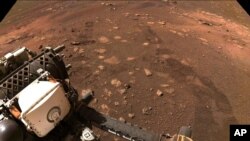The U.S space agency NASA says its Perseverance rover has converted carbon dioxide (CO2) in the Martian atmosphere to oxygen, a critical step toward future human exploration of Mars.
NASA on Monday said a toaster-size, experimental instrument on the rover called the Mars Oxygen In-Situ Resource Utilization Experiment (MOXIE), produced about 5.4 grams of oxygen in an hour — enough to keep an astronaut healthy for about 10 minutes.
NASA says in regular operation, MOXIE is designed to produce up to 10 grams of oxygen in an hour.
The space agency says MOXIE is an “exploration technology investigation,” like the Ingenuity helicopter and other instruments taken to Mars along with the Perseverance rover. In other words, it is designed to test a certain technology that, if successful, will be applied on a larger scale in future missions on the Red Planet.
NASA’s Space Technology Mission Directorate (STMD) administrator Jim Reuter says there are still more tests for MOXIE to pass, but the results of the initial demonstration show a lot of promise toward the goal of one day seeing humans on Mars,
Reuter said oxygen is also a key ingredient in rocket propellant and future Mars missions will have to produce it there to make the trip home.
NASA says MOXIE works by separating oxygen atoms from carbon dioxide molecules, which are made up of one carbon atom and two oxygen atoms through a process that involves heating them to 800 degrees Celsius. The Martian atmosphere is 96% carbon dioxide.
The agency says a hypothetical future mission would require creating about one ton of oxygen for four astronauts to live and work on Mars for a year. About 25 tons would be needed to create the propellant needed to get them home.
The agency says a larger, more powerful descendant of MOXIE, weighing about a ton, would be required to meet those needs.









